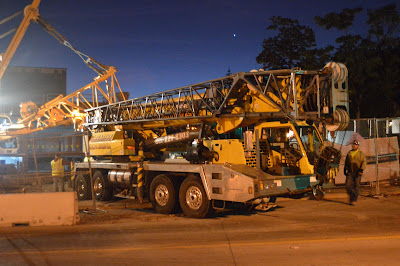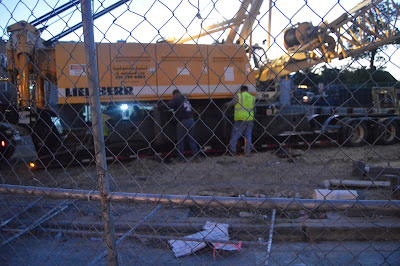 |
| Construction 20170630 9706 |
Rob Storm posted seven photos of moving the housing for a Manitowoc 4600 between its tracks and a truck with the comment: "assembly of a 4600 in Brussels Belgium."
 |
| 1 Ben StalveyGroup Admin Neat odd tip on this 4600 |
 |
| 2 |
 |
| 3 |
 |
| 4 |
 |
| 5 |
 |
| 6 |
 |
| 7 That must be a bunch of managers that are riding the load. That is a dangerous ego trip. |
 |
| 20140526 0062 |
 |
| Construction 20170822am 3010 |
A better picture of the assist crane than I was able to get at night.
 |
| Grove 9000e |
 |
| Construction 20170822am 3017 |
 |
| 20171001 6365 |
These plates were light enough that they could lift the far-side plate by reaching over the crane's house, and they could haul both plates as one trailer load.
This load was leaving at 12:19am. The site manager explained that it was important to get the load rolling quickly because it needed to come back yet that morning for another load. Since their yard is in Rockford, IL, a round trip takes a while.
Taking a second look at the photo, they are using the special trailer and tractor that has three axles each. So, even though that load is rather small, it is heavy. Using this trailer explains why they needed it back by 6:00am --- that is the trailer that will haul the "guts" (house) of the crane.
The mobile crane has sucked in its boom and is lowering it so that...
...it can move out into the street.
The crawler is swinging his boom around so that...
...it can be lowered along Main Street.
I took over 200 photos. I'm going to skip the boom and counterweight disassembly because the main point of this posting is how they load the housing. But I will observe that it does not require any more trucks to haul the boom than it does for a mobile crane because they add a boom section to each of the trucks that is needed anyhow to haul the counterweights.
It does require a couple of extra trucks to haul a crawler than a mobile crane because a trailer is needed for each track. Note that they have moved the assist crane right next to the main crane and that the truck trailer is also close to the assist crane. The boom sections were relatively light because the assist crane could handle them with a long boom at a rather low angle, that is, a fairly long radius. But for the crawler tracks, they were careful to use a shorter boom and keep it pretty close to vertical. That is, a track is heavy enough that the load chart for the 9000e would allow just a short radius.
They have the boom back out and up and are lifting the rigging for the track that they had placed on the ground before the move. A trailer is parked close by to receive the track.
I walked around the street corner and down...
...Maple Avenue to get this view of them lifting the second track. (Maple doesn't have as much street lighting as Main does.)
Turning the track to align with the trailer.
After both tracks are off...
...they turn the housing 90 degrees. We are looking down the access path where they will back the oversize-load trailer under the housing.
5:48 The second track is being chained down and the truck will be moved out of the way so that the mobile crane can get out.
5:54 The boom is in and down and they are bringing in the truck with the special heavy-load tractor and trailer. In addition to three axles, the bed of the trailer is below the top of the wheels. That is, this is a lowboy trailer.
5:58 As the sky starts turning blue, the mobile crane is leaving the site and...
6:03 ...going back to the their yard.
In the meantime, they have been pumping up the four hydraulic jacks on the crane housing.
And they are backing the lowboy trailer towards the housing. The trucks with counterweights and a boom section are parked along the other side of Main Street. When the housing is loaded, each crew member will drive one of the trucks back to the yard.
6:13 Different crew members are watching different angles and clearance points as they back the trailer wheels past the jacks. Note the bottom of the jack in front of the wheel. You can see it is a telescoping ram and that the inner ram is sticking out about a half-foot. The inner ram on the right jack is extended just a couple of inches. This allows them to keep the housing level on uneven ground.
6:13 It is still 6:13 so they are making good progress threading the trailer under the housing. (I do wish Microsoft Photo would add seconds to the time stamp displayed in the File Info.)
They spent some time making sure the trailer was under the correct part of the housing.
6:20 When they were happy with the position,...
...they pulled in the hydraulic jacks to set the housing on the trailer.
6:23 He is unloading chains and straps that are stored on the back of the tractor's cab. The chains and straps are used to tie down the load.
6:29 They are pushing the outriggers that hold the jacks back up against the frame.
6:29 The outriggers are being locked in travel position.
6:31 The sun is up and they are now ready to lower the boom base and mast.
6:32 The boom base is resting on the trailer. And, because the sun has come up, I remember to reduce the ISO to 3200.
So now the tie-bars are folding as the mast continues to lower.
Still folding.
6:33 Mast is down. One advantage of Main Street being closed is that I can stand in the street to get a good angle on the rig. Assuming the man is around 6-feet tall, the height of the load is not significant. In fact, they don't have an "Oversize Load" sign on the trailer. I assume the width of the crane's housing is right at the maximum normal truck width.
6:34 Some final tie-down work on the boom.
They loaded part of the boom tip in some spare room on one of the track trucks.
A crew member fetched the other track truck from where they temporarily stored it.
6:38 The big load pulls out and heads for the yard.
A truck that had been temporarily parked on site along Maple Avenue...
6:41 ...turns south on Main to head back to the yard.
In the meantime, they backed the truck with a crawler track back onto the construction site.
And lowered the lowboy trailer to leave it there.
6:42 They needed the tractor to take back a regular trailer. The white pickup truck is that of the site manager. He will notify the sub-contractor that provided the road barriers that he can pick them up and haul them away. The barricades should be gone by the 7:00am deadline.
4:08 Looking back through the pictures I took, they brought one empty trailer as a load on another trailer. That explains why they had more trailers than tractors. They will have to deadhead a tractor back to the site to pick up the lowboy they left on the construction site.
(new window)











































No comments:
Post a Comment